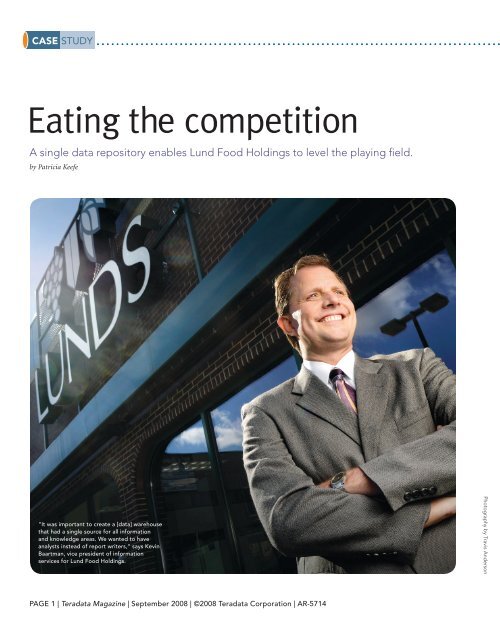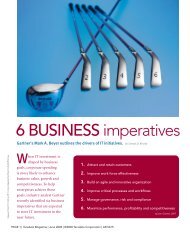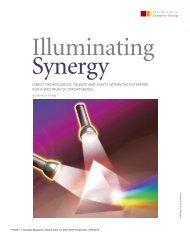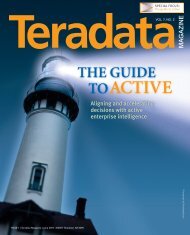Download PDF - Teradata
Download PDF - Teradata
Download PDF - Teradata
- No tags were found...
You also want an ePaper? Increase the reach of your titles
YUMPU automatically turns print PDFs into web optimized ePapers that Google loves.
CASE STUDYEating the competitionA single data repository enables Lund Food Holdings to level the playing field.by Patricia Keefe“It was important to create a [data] warehousethat had a single source for all informationand knowledge areas. We wanted to haveanalysts instead of report writers,” says KevinBaartman, vice president of informationservices for Lund Food Holdings.Photography by Travis AndersonPAGE 1 | <strong>Teradata</strong> Magazine | September 2008 | ©2008 <strong>Teradata</strong> Corporation | AR-5714
The retail game in general is not forthe weak-kneed—grocery retail, evenless so. Consider that the average independentgrocer in 2007 reported a 1.94%net profit (before taxes), according tothe National Grocers Association, and itbecomes clear that if you are going to play,you had better come prepared. For LundFood Holdings Inc., that means looking to“big company” solutions while emphasizingstrategic expertise when it comes totechnology partners.The small Minnesota-based, high-endgrocery chain needed to modernize itstime-consuming process of financial analyticsin order to level the competitiveplaying field and give its analysts bettervisibility into the company’s business andfinancial operations. It also needed a foundationcapable of supporting plans forbusiness intelligence (BI)-driven profitbuildingprograms.The 21-store enterprise bucked conventionalwisdom when it decided to tap intoa “big enterprise” data warehouse and BIplatform to make better use of its small ITand financial labor pools. The basic planwas to simplify, update and speed up theprocess of data collection, integration anddistribution, as well as report creationand analysis.“There’s much excitement about thisright now on the business side, especiallyin cases where they had to wait for monthendreports before,” says Kevin Baartman,vice president of information services. Atissue were the missed opportunities thatthose late data deliveries represented,according to Curtis Funk, director of thegrocery area. “It’s seldom too late to react;it was just the time-wasting when youcould have reacted sooner,” Funk explains.Too little data, too lateLund’s channeling of information into fiveseparate data silos had led to a cumbersomeLund Food HoldingsInc. at a glance> Headquarters: Edina, Minn.> Operation: Chain of upscalegrocery markets featuringgourmet, high-quality foods,wines and spirits shops, floraland catering services, a culinaryschool, cooking demos, pharmaciesand online shopping withhome delivery> Founded: The privately heldcompany took its present formin 1997 with the merger of theLunds and Byerly’s chains> Locations: 21—10 Lunds and 11Byerly’s stores in Minnesota> CEO: Russell “Tres” T. Lund III> Web site:www.lundsandbyerlys.comextraction and reconciliation process thatdelivered results in spreadsheets. Thisformat forced the analysts to spend as muchtime preparing and reconciling reports fromdifferent operational systems as they didanalyzing them. The system inhibited theirability to react in a timely manner to theresulting data points and diverted resourcesfrom more strategic tasks. “It was importantto create a [data] warehouse that had asingle source for all information and knowledgeareas. We wanted to have analystsinstead of report writers,” says Baartman,who also sought to reduce the reportingburden on his staff. Analytics efforts werefurther handicapped by the inability to drilldown deeper into the data to get to the levelneeded to make smart decisions.This lack of data granularity was particularlyfrustrating for Funk, because itcompromised his ability to look at anyparticular store and determine how to correctproblems. “We could get to a categorylevel, like frozen food or pizza, but not godeeper, for example, to the brand level,”he explains. This left the company guessingwhich brands were over- or underperforming,why that might be and whatshould be done about it.Baartman knew he needed to moveLund Food Holdings to a single, integrateddata repository intertwined withBI. After networking with some peersin the industry, he quickly narrowed inon one solution. “They told me I reallyneeded to take a look at <strong>Teradata</strong>, thatit was becoming much more attractiveto mid-tier companies,” he says. He alsofound that the technology today takes lesstime to deploy and costs much less in thedevelopment process.“I never thought we’d be able to afford<strong>Teradata</strong>,” says Baartman. But he soondiscovered that the technology was competitivelypriced. Also attractive was the<strong>Teradata</strong> mantra of “simple and capable.”According to Baartman, “That [concept]pretty much hits the nail on the head interms of the ease of use for the staff, andthe capability of getting the informationto the people who need it. So far, the solutionwe’ve put into place does exactlythat.” Adds Funk, “We’re now able todownload information from the operationssystem on a daily basis, instead ofwaiting for a monthly report.”Baartman looked briefly at doing somesystem consolidation with structuredquery language (SQL) and deploymentvia a spreadsheet program, but he soondetermined that was not something hewanted to get into. He also looked “realquick” at IBM and Oracle, but the technicalknowledge needed for those systemsPAGE 2 | <strong>Teradata</strong> Magazine | September 2008 | ©2008 <strong>Teradata</strong> Corporation | AR-5714
CASE STUDYdid not fit with the core competency ofLund’s IT staff. Baartman did not wantto have to create “specialists” with hislimited resources. <strong>Teradata</strong> was not only“really good at solving those enterprisewideproblems,” he says, but also offeredimpressive performance.While technical features certainlyweighed heavily on the vendor selection,the deciding factor had more to dowith strategic partnering, which is where<strong>Teradata</strong>’s more than 25 years of marketexpertise came to bear. Retail expertise wascritical for the company. “I wanted a strategicpartner versus a technical partner,”says Baartman, adding that in his view,“the value lies in the expertise; the technologyis becoming a commodity.” Aftera business opportunity assessment was“The system was easy to work with, quickto implement and, so far, has performed asadvertised. There have been no unpleasantsurprises. From the time we turned on thesystem to the time we interfaced and putdata in the warehouse—it was days.”—Kevin Baartman, vice president of information services, Lund Food Holdings Inc.completed, Baartman says, it becameevident that <strong>Teradata</strong> offered more thantechnical expertise: “<strong>Teradata</strong> had a lot ofretail experience, which was very importantto me. I needed professional servicesto help me deploy this [solution] in atimely manner.”Quick turnaroundAfter three weeks of pilot testing, the<strong>Teradata</strong> solution was deployed in March2008, just five months after the companysigned a contract. “The system was easy towork with, quick to implement and, so far,has performed as advertised. There havebeen no unpleasant surprises,” Baartmansays. “From the time we turned on the systemto the time we interfaced and put data inthe warehouse—it was days. It was relativelypainless getting data out of the operationalsystem and putting it into the repository.”Lund Food Holdings is looking for an18- to 24-month return on investment(ROI) in the form of increased gross marginsand sales, driven by gains in efficiencies,consistency and speed that areexpected to make business users’ decisionmaking more agile and accurate. A moreimmediate impact has been timely accessto information. “I’d say we’re movingfrom, in many cases, weekly reports todaily reports,” says Baartman. He was alsolooking for the analysts to do a lot of thedrill-down and analyses on their desktops,an expectation already being metvia MicroStrategy. “Of course, with thatcomes more issues; the more we give them,the more they want,” he adds with a laugh.Looking to the futureHaving launched the first “basic” phaseof its data warehouse strategy, LundFood Holdings is gearing up to tacklemore problem-specific issues by expandingits BI applications and leveragingMicroStrategy’s information dashboards.Phase II, a two- to four-month effort, willfocus on better understanding the buyingbehavior of customers (market basketanalysis), as well as supporting the onlinecustomer service staff. A key focus will beon inventory optimization, says Baartman.This involves examining how to refine thePAGE 3 | <strong>Teradata</strong> Magazine | September 2008 | ©2008 <strong>Teradata</strong> Corporation | AR-5714
assortment of products in the store, theamount of product on the shelves and theeffectiveness of various promotions. PhaseIII, slated to happen by year’s end, will coverthe development of a customer loyalty programand shopping pattern data, while alsoextracting cross-merchandising data.At some point during the year, Baartmansays, IT will build a bridge to pull data fromits financial applications into <strong>Teradata</strong> andMicroStrategy. Several years down the road,during Phase IV, Baartman plans to deployMicroStrategy Mobile to provide BI reportsto mobile users.MicroStrategy offers better decision makingStrong expertise in retail business intelligence (BI), coupled with a strong competencein category management, helped to sell MicroStrategy’s BI platformto Vice President of Information Systems Kevin Baartman’s business peers at LundFood Holdings Inc. IT chose the data warehouse, but Baartman pulled togethera committee of about 10 people from relevant function areas and IT to settle ona BI platform. He wanted to make sure that business needs were met and thatusers were comfortable with the tool. Over a two-month period, the committeehelped create the requirements and request for proposals, and it was involvedin the testing phase. “The BI tool is the layer between the business and thetechnology—it was important that [users] choose it,” Baartman explains.The business side desperately needed to free up and better deploy its financialstaff. It needed to gain more valuable views into store operations, productsales, inventory management and financial performance. Under the old system,the analysts were spending their time assembling reports instead of providingstrategic insights. The business side also wanted to get better data faster to itsanalysts, says Curtis Funk, director of the grocery area. One way of doing thiswas empowering them to create customized reports at their desktops insteadof having to run to IT every time they needed something. “We’re already seeingreduced dependency between the business users and IT when it comes toreports,” says Baartman.“MicroStrategy allows us to ask more questions across a broader spectrumof the business,” says Funk. “We can simply go further, really identify what theissues are and come up with more solutions.” He also praised the BI platform forits ability to add new metrics to existing data: “No matter how we scope out areport, once you see it, you will run back to IT looking for three more data variables.MicroStrategy is much more adaptable in how it manages data.”Baartman notes that even when analysts make the same decisions they wouldhave made before, they can now do so with much more confidence. The committeelooked at two packages. MicroStrategy easily gained the upper hand fora number of reasons, including its level of integration with <strong>Teradata</strong> technology,its platform capabilities, ease of use on the desktop, functionality and scalability.“We did not want to hit the limits of the tool six or eight months down the road,”says Baartman.—P.K.While Baartman does not foresee a directimpact on third-party business partnersfor some time, he does expect that betterdata—and more timely access to it—willbetter equip category managers to track theperformance of suppliers and show thosesuppliers factual data regarding their performancein stores.Even as Lund Food Holdings looksahead to launching new initiatives, such asa customer loyalty program and betterpositionedmarket promotions, the futureis now. Just months into its deploymentof a data warehouse and BI platform,the company is already ringing up thepayoff from data integration, informationconsistency and drill-down capabilitiesin the form of improved decision makingand deployment of staff resources. In ahighly competitive market populated bylarge-scale enterprises, this grocery chain isbuilding a strong foundation on analyticsto not only play but win. Its early ROI goesto show that small companies willing totake on big technologies can create a recipefor success. TPatricia Keefe is a freelance writer and editorspecializing in business and technology.Behind the solution:Lund Food Holdings Inc.Database: <strong>Teradata</strong> Database V2R6.2Server: Single-node <strong>Teradata</strong> 5450ServerDBAs: OneData model: <strong>Teradata</strong> Retail LogicalData Model (RLDM)Operating system: UNIX MP-RASStorage: 2.8TB<strong>Teradata</strong> utilities: <strong>Teradata</strong> Tools andUtilities 8.2Tools/applications: Retail Decisions,<strong>Teradata</strong> Warehouse Miner and productsfrom MicroStrategyPAGE 4 | <strong>Teradata</strong> Magazine | September 2008 | ©2008 <strong>Teradata</strong> Corporation | AR-5714







